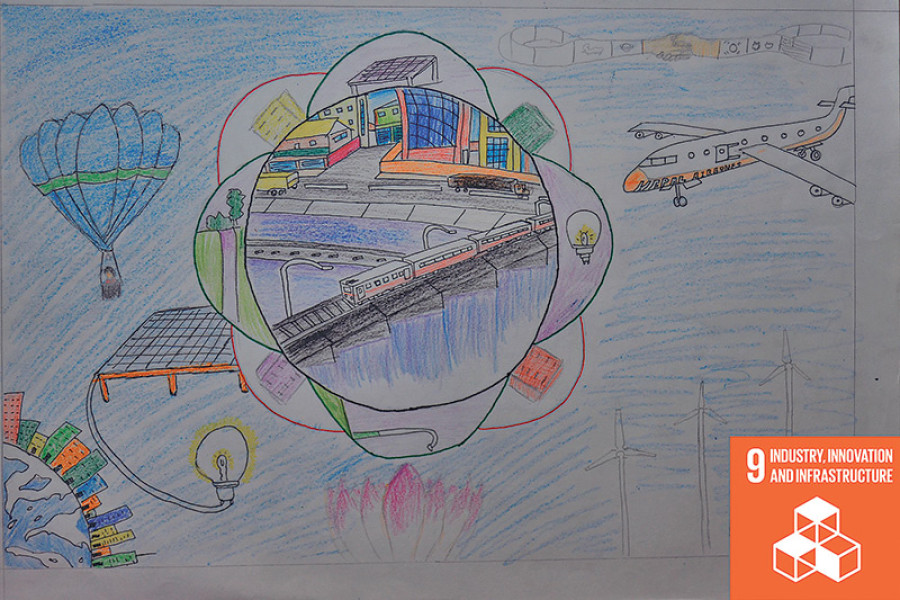Opinion
Innovation for development
Basic infrastructure like roads, information and communication technologies, power plants, etc remains scarce in many developing countries. About 2.6 billion people in the developing world are facing difficulties in accessing round-the-clock electricity.
Mahabir Pun
Basic infrastructure like roads, information and communication technologies, power plants, etc remains scarce in many developing countries. About 2.6 billion people in the developing world are facing difficulties in accessing round-the-clock electricity. As many as 2.5 billion people worldwide lack access to basic sanitation and almost 800 million people lack access to water. Hundreds of millions of these people live in Sub Saharan Africa and South Asia. Around 1 to 1.5 billion people do not have access to reliable phone services.
The SDG related to industry, innovation and infrastructure is connected to several other SDGs. Quality infrastructure is positively related to the achievement of social, economic and political goals. Inadequate infrastructure leads to a lack of access to markets, jobs, information and training, thus creating a major barrier for doing business. Undeveloped infrastructure limits access to health care and education. For many African countries, particularly lower-income ones, infrastructural constraints affect firm productivity by around 40 percent.
Job creation
The manufacturing sector is an important employer, accounting for around 470 million jobs worldwide in 2009, which is about 16 percent of the world’s workforce of 2.9 billion. In 2013, it was estimated that there were more than half a billion jobs in manufacturing. The job multiplication effect of industrialisation has a positive impact on society. Every job in manufacturing creates 2.2 jobs in other sectors. Small and medium-sized enterprises that engage in industrial processing and manufacturing are the most critical for the early stages of industrialisation and are typically the largest job creators. They make up over 90 percent of business worldwide and account for between 50 and 60 percent of employment.
In countries where data are available, the number of people employed in the renewable energy sector is presently around 2.3 million. Given the present gaps in information, this is no doubt a very conservative figure. Because of a rising interest in energy alternatives, by 2030, the renewable energy sector could provide 20 million jobs. Least developed countries have immense potential for industrialisation in food and beverages (agro-industry), and textiles and garments, with good prospects for sustained employment generation and higher productivity. Middle-income countries can benefit from establishing basic and fabricated metals industries, which offer a range of products to supply rapidly growing international demand. In developing countries, barely 30 percent of agricultural production undergoes industrial processing. In high-income countries, 98 percent is processed. This suggests that there are great opportunities for developing countries in agribusiness.
Balancing priorities
Basic services are absolute necessities in all countries, both developed and developing. We all know that developed countries invest huge amounts of money in innovation, industrialisation and infrastructure development in comparison to least developed countries. Of course, Nepal is also investing a sizeable amount of money in providing basic services and in developing infrastructure within its capacity, and is hoping to become a developing nation. However, I believe that we will not see real results until Nepal gives the highest priority to utilising the talents of its innovative young people.
I believe that a major reason why Nepal and other least developed countries have not been able improve their economies is because few of them are according priority to innovation and research. They are also not investing in talented and innovative human capital. If a country like Nepal focuses only on providing basic services and building basic infrastructure but does not make any investments in nurturing the talents of its people, it will always remain a least developed country. Therefore, least developed countries like Nepal must start giving priority to research and innovation just as they prioritise basic services and infrastructure building.
Retaining human resources
Human resources are the most important capital for the development of any country. Until we build big industries and create enough job opportunities for all Nepalis, it will be difficult, if not impossible, to retain even unskilled and semi-skilled human resources in Nepal. The same is true for educated, qualified and talented human resources, a majority of whom are all leaving for developed countries. We need to start building innovation centres in Nepal in order to develop a better environment for retaining our talented people and nurturing their talents for the economic development of Nepal.
That is why I have been lobbying with the government of Nepal for establishing an autonomous innovation centre. Such a centre will help nurture the talents of Nepalis and use these talents for Nepal’s economic development. If something like this happens, I am confident that Nepal will become a developed country in about 40 years.
Digital connectivity makes the lives of rural people much easier through services such as education, health, communication, e-commerce and so on. In the near future, digital connectivity for every citizen will be a must even in rural areas. Without it, the government will be unable to delivers basic services to people. In my opinion, digital connectivity should be a right. It can also support people in accessing other services they are entitled to. Simply connecting people to the internet is not enough. There should be all kinds of content and services available for rural populations in the languages they understand. I believe that such access would expedite development, particularly in rural areas.
Pun, the winner of 2007 Magsaysay Award, is a social worker and is championing innovation for development in Nepal; this article is part of a weekly series on SDGs




 8.12°C Kathmandu
8.12°C Kathmandu










